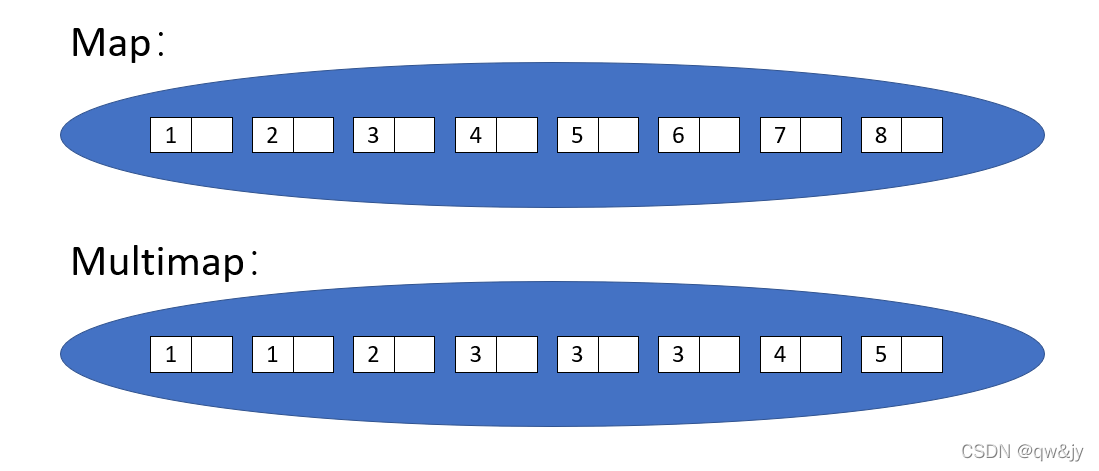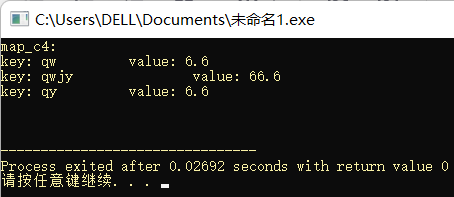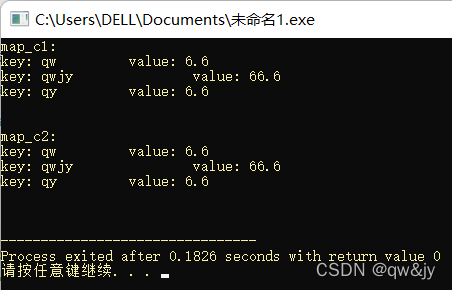?
?
?
??Map 和 multimap 将 key/value pair 当作元素进行管理。它们可根据 key 的排序准则自动为元素排序。Multimap 允许重复元素,map 不允许,如下图所示。

map 和 multimap 包含在头文件
#include <map>
在其中,map 和 multimap 被定义为命名空间 std 内的 class template:
namespace std {
template <typename Key, typename T,
typename Compare = less<Kay>,
typename Allocator = allocator<pair<const Key, T> > >
class map;
template <typename Key, typename T,
typename Compare = less<Kay>,
typename Allocator = allocator<pair<const Key, T> > >
class multimap;
}
第一个 template 实参将成为元素的 key 类型,第二个 template 实参将成为元素的 value 类型。Map 和 multimap 的元素类型 Key 和 T 必须满足以下两个条件:
- Key 和 value 都必须是 copyable (可复制的)或 movable (可搬移的)。
- 对指定的排序准则而言,key 必须是comparable (可比较的)。
注意,元素类型(value_type)是个 pair < const Key,T>。
第三个 template 实参可有可无,用来定义排序准则。和 set 一样,这个排序准则必须定义为 strict weak ordering。元素的次序由它们的 key 决定和 value 无关。排序准则也可以用来检查相等性:如果两个元素的 key 彼此都不小于对方,两个元素被视为相等。
如果用户未传入某个排序准则,就使用默认的 less<> 排序准则——以 operator < 进行比较。
??关于multimap,我们无法预测所有“拥有等价 key ”的元素的彼此次序,不过它们的次序是稳固不变的。C++11保证 multimap 的安插和抹除动作都会保留等价元素的相对次序。
??第四个 template 实参也是可有可无,用来定义内存模型。默认的内存模型是 allocator,由 C++ 标准库提供。
??“排序准则”,必须定义 strict weak ordering,其意义如下:
- 必须是非对称的
对 operator < 而言,如果 x < y 为 true,则 y < x 为 false。
对判断式(predicate)op() 而言,如果 op(x, y) 为 true,则 op(y, x) 为 false。 - 必须是可传递的
对 operator < 而言,如果 x < y 为 true 且 y < z 为 true,则 x < z 为 true。
对判断式 op() 而言,如果 op(x, y) 为 true 且 op(y, z) 为 true,则 op(x, z) 为 true。 - 必须是非自反的
对 operator < 而言,x < x 永远为 false。
对判断式 op() 而言,op(x, x) 永远为 false。 - 必须有等效传递性。大体意义是:如果 a 等于 b 且 b 等于 c,那么 a 必然等于 c。
这意味着对于操作符 <,若 !(a<b) && !(b<a) 为 true 且 !(b<c) && !(c<b) 为 true,那么 !(a<c) && ! (c<a) 亦为 true。
这也意味着对于判断式 op(),若 op(a, b)、 op(b, a)、 op(b, c)和 op(c, b) 都为 false,那么 op(a, c)和 op(c, a) 为 false。
?
?
?
?
?
?
结构
和其他所有关联式容器一样, map/multimap 通常以平衡二叉树完成(红黑树),如下图所示。C++standard 并未明定这一点,但是从 map和 multimap各项操作的复杂度自然可以得出这一结论。通常set、 multiset、map 和 multimap 使用相同的内部结构,因此,你可以把因 set 和 multiset 视为特殊的 map 和 multimap,只不过 set 元素的 value 和 key 是同一对象。因此,map 和 multimap 拥有 set 和 multiset 的所有能力和所有操作。当然,某些细微差异还是有的:首先,它们的元素是 key/value pair,其次,map 可作为关联式数组(associative array)来运用。

??Map 和 multimap 会根据元素的 key 自动对元素排序。这么一来,根据已知的 key 查找某个元素时就能够有很好的效率,而根据已知 value 查找元素时,效率就很糟糕。“自动排序”这一性质使得 map 和 multimap 身上有了一条重要限制:你不可以直接改变元素的 key,因为这会破坏正确次序。要修改元素的 key,必须先移除拥有该 key 的元素,然后插入拥有新 key/value 的元素。从迭代器的观点看,元素的 key 是常量。至于元素的 value 倒是可以直接修改,当然前提是 value 并非常量。
?
?
?
?
?
?
构造操作
| 操作 | 描述 |
|---|---|
| map c | Default 构造函数,建立一个空 map/multimap,不含任何元素 |
| map c(op) | 建立一个空 map/multimap,以 op 为排序准则 |
| map c(c2) | Copy 构造函数,为相同类型之另一个 map/multimap 建立一份拷贝,所有元素均被复制 |
| map c = c2 | Copy 构造函数,为相同类型之另一个 map/multimap 建立一份拷贝,所有元素均被复制 |
| map c(rv) | Move 构造函数,建立一个新的 map/multimap,有相同类型,取 rvalue rv 的内容(始自C++11) |
| map c = rv | Move 构造函数,建立一个新的 map/multimap,有相同类型,取 rvalue rv 的内容(始自C++11) |
| map c(beg, end) | 以区间 [beg, end) 内的元素为初值,建立一个 map/multimap |
| map c(beg, end, op) | 以区间 [beg, end) 内的元素为初值,并以 op 为排序准则,建立一个 map/multimap |
| map c(initlist) | 建立一个 map/multimap,以初值列 initlist 的元素为初值(始自C++11) |
| map c = initlist | 建立一个 map/multimap,以初值列 initlist 的元素为初值(始自C++11) |
| c.~map() | 销毁所有元素,释放内存 |
| 其中,map 可为下列形式: | |
| map | 描述 |
| – | – |
| map< Key, Val > | 一个 map,以 less<>(operator <)为排序准则 |
| map< Key, Val, Op > | 一个 map,以 Op 为排序准则 |
| multimap< Key, Val > | 一个 multimap,以 less<>(operator <)为排序准则 |
| multimap< Key, Val, Op > | 一个 multimap,以 Op 为排序准则 |
#include <iostream>
#include <map>
#include <string>
using namespace std;
struct op{
bool operator() (const string& a, const string& b) const{
return a > b;
}
};
int main(){
map<string, float> c;
c.insert(pair<string, float>("qw", 6.6));
c.insert(pair<string, float>("qy", 6.6));
c.insert(pair<string, float>("qwjy", 66.6));
map<string, float> c1;
map<string, float> c2(op);
map<string, float> c3(c);
map<string, float> c4 = c;
printf("map_c4:\n");
for(map<string, float>::iterator p = c4.begin(); p != c4.end(); p ++)
cout << "key: " << p->first << "\t\t"
<< "value: " << p->second << endl;
printf("\n\n");
return 0;
}

?
?
?
?
?
?
非更易型操作
| 操作 | 描述 |
|---|---|
| c.key_comp() | 返回“比较准则”(comparison criterion) |
| c.value_comp() | 返回针对 value 的“比较准则”(那是个对象,用来在一个 key/value pair 中比较 key) |
| c.empty() | 返回是否容器为空(相当于 size() == 0 但也许较快) |
| c.size() | 返回目前的元素个数 |
| c.max_size() | 返回元素个数之最大可能量 |
| c1 == c2 | 返回 c1 是否等于 c2(对每个元素调用==) |
| c1 != c2 | 返回 c1 是否不等于 c2(相当于 !(c1 == c2)) |
| c1 < c2 | 返回 c1 是否小于 c2 |
| c1 > c2 | 返回 c1 是否大于 c2(相当于c2 < c1) |
| c1 <= c2 | 返回 c1 是否小于等于 c2(相当于!(c2 < c1)) |
| c1 >= c2 | 返回 c1 是否大于等于 c2(相当于!(c1 < c2)) |
#include <iostream>
#include <map>
#include <string>
using namespace std;
struct op{
bool operator() (const string& a, const string& b) const{
return a > b;
}
};
int main(){
map<string, float, op> c;
c.insert(pair<string, float>("qw", 6.6));
c.insert(pair<string, float>("qy", 6.6));
c.insert(pair<string, float>("qwjy", 66.6));
map<string, float, op> c1 = c;
map<string, float, op> c2;
c2.insert(pair<string, float>("qwjy", 66.6));
c2.insert(pair<string, float>("qy", 6.6));
c2.insert(pair<string, float>("qw", 6.6));
printf("map_c:\n");
for(map<string, float>::iterator p = c.begin(); p != c.end(); p ++)
cout << "key: " << p->first << "\t\t"
<< "value: " << p->second << endl;
printf("\n\n");
printf("key_comp: %s\n", c.key_comp()("qw", "qa") ? "true" : "false");
printf("key_comp: %s\n", c.key_comp()("qa", "qw") ? "true" : "false");
printf("value_comp: %s\n", c.value_comp()(pair<string, float>("qw", 0.6), pair<string, float>("qy", 66.6)) ? "true" : "false");
printf("value_comp: %s\n", c.value_comp()(pair<string, float>("qy", 0.6), pair<string, float>("qw", 66.6)) ? "true" : "false");
printf("empty: %s\n", c.empty() ? "true" : "false");
printf("size: %d\n", c.size());
printf("max_size: %lld\n", c.max_size());
printf("c1 == c2: %s\n", c1 == c2 ? "true" : "false");
return 0;
}

?
?
?
?
?
?
查找操作
| 操作 | 描述 |
|---|---|
| c.count(val) | 返回“key 为 val”的元素个数:如果 key 存在于容器中,则返回1,因为映射仅包含唯一 key 。如果键在Map容器中不存在,则返回0。 |
| c.find(val) | 返回“key 为 val”的第一个元素,找不到就返回 end()。该函数返回一个迭代器或常量迭代器,该迭代器或常量迭代器引用键在映射中的位置。 |
| c.lower_bound(val) | 返回“key 为 val”之元素的第一个可安插位置,也就是“key >= val”的第一个元素位置 |
| c.upper_bound(val) | 返回“key 为 val”之元素的最后一个可安插位置,也就是“key > val”的第一个元素位置 |
| c.equal_range(val) | 返回“key 为 val”之元素的第一个可安插位置和最后一个可安插位置,也就是“key == val”的元素区间 |
#include <iostream>
#include <map>
#include <string>
using namespace std;
int main(){
map<string, float> c;
c.insert(pair<string, float>("qw", 6.6));
c.insert(pair<string, float>("qy", 6.6));
c.insert(pair<string, float>("qwjy", 66.6));
printf("map_c:\n");
for(map<string, float>::iterator p = c.begin(); p != c.end(); p ++)
cout << "key: " << p->first << "\t\t"
<< "value: " << p->second << endl;
printf("\n\n");
printf("count: %d\n", c.count("qw"));
printf("find: key-%s value-%.1f\n", c.find("qwjy")->first.c_str(), c.find("qwjy")->second);
printf("lower_bound: key-%s value-%.1f\n", c.lower_bound("q")->first.c_str(), c.lower_bound("q")->second);
printf("upper_bound: key-%s value-%.1f\n", c.upper_bound("qw")->first.c_str(), c.upper_bound("qw")->second);
cout << "equal_range: " << c.equal_range("qw").first->first << "\t" <<
c.equal_range("qw").second->first << endl;
return 0;
}

?
?
?
?
?
?
赋值
| 操作 | 描述 |
|---|---|
| c = c2 | 将 c2 的全部元素赋值给 c |
| c = rv | 将 rvalue rv 的所有元素以 move assign 方式给予 c (始自C++11) |
| c = initlist | 将初值列 initlist 的所有元素赋值给 c (始自C++11) |
| c1.swap(c2) | 置换 c1 和 c2 的数据 |
| swap(c1, c2) | 置换 c1 和 c2 的数据 |
#include <iostream>
#include <map>
#include <string>
using namespace std;
int main(){
map<string, float> c;
c.insert(pair<string, float>("qw", 6.6));
c.insert(pair<string, float>("qy", 6.6));
c.insert(pair<string, float>("qwjy", 66.6));
map<string, float> c1 = c;
map<string, float> c2;
printf("map_c1:\n");
for(map<string, float>::iterator p = c1.begin(); p != c1.end(); p ++)
cout << "key: " << p->first << "\t\t"
<< "value: " << p->second << endl;
printf("\n\n");
swap(c1, c2);
printf("map_c2:\n");
for(map<string, float>::iterator p = c2.begin(); p != c2.end(); p ++)
cout << "key: " << p->first << "\t\t"
<< "value: " << p->second << endl;
printf("\n\n");
return 0;
}

?
?
?
?
?
?
元素访问
??关联式容器并不提供元素的直接访问,你必须依靠 range-based for 循环或迭代器进行访问。但 map 是个例外,提供了如下表所述的方法直接访问元素。
先看看 range-based for 循环(C++11新特性):
#include <iostream>
#include <map>
#include <string>
using namespace std;
int main(){
map<string, float> coll;
coll.insert(pair<string, float>("qw", 6.6));
for(auto elem : coll){
cout << "key: " << elem.first << "\t"
<< "value: " << elem.second << endl;
}
return 0;
}
其中的 elem 是个 reference,指向“容器 coll 中目前正被处理的元素”。因此 elem 的类型是 pair<string, float>。表达式
elem.first 取得元素的 key,而表达式 elem.second 取得元素的 value。
下面看看迭代器访问(C++11之前使用的方法):(迭代器操作的详细操作方法见下节)
#include <iostream>
#include <map>
#include <string>
using namespace std;
int main(){
map<string, float> coll;
coll.insert(pair<string, float>("qw", 6.6));
for(map<string, float>::iterator p = coll.begin(); p != coll.end(); p ++)
cout << "key: " << p->first << "\t"
<< "value: " << p->second << endl;
return 0;
}
在这里,迭代器 pos 被用来迭代穿越整个由“以 const string 和 float 组成的 pair”所构成的序列,你必须使用 operator -> 访问每次访问的那个元素的 key 和 value。所以 key (first)值是无法改变的,会引发错误;value(second)值是可以改变的。
??如果你一定得改变元素的 key,只有一条路:以一个“value 相同”的新元素替换掉旧元素。

?
?
?
?
| 操作 | 描述 |
|---|---|
| c[key] | 安插一个带着 key 的元素——如果尚未存在于容器内。返回一个 reference 指向带着 key 的元素( only for nonconstant maps ) |
| c.at(key) | 返回一个 reference 指向带着 key 的元素(始自C++11) |
| ??at() 会依据它收到的“元素的 key”取得元素的 value;如果不存在这样的元素则抛出 out_of_range 异常。 | |
| ??至于operator [ ],其索引就是 key。这意味着 operator [ ] 的索引可能属于任何类型,不一定是整数。如此的接口就是所谓的关联式数组(associative array)接口。“operator [ ] 的索引类型不必然是整数”。 | |
| ??如果你选择某 key 作为索引,容器内却没有相应元素,那么 map 会自动安插一个新元素,其 value 将被其类型的 default 构造函数初始化。因此,你不可以指定一个“不具 default 构造函数”的 value 类型。注意,基础类型都有一个 default 构造函数,设立初值 0。 |
提供类似数组的访问方式有好也有坏:
- 优点是你可以通过更方便的接口对map安插新元素。例如:
map<string, float> coll;
coll["otto"] = 6.6;
语句:coll[“otto”] = 6.6; 处理过程如下:
- 处理 coll[“otto”]:
①如果存在 key 为"otto"的元素,上式会返回元素的 reference。
②如果没有任何元素的 key 是"otto",上式便为 map 自动安插一个新元素,令其 key 为"otto",其 value 则以, default 构造函数完成,并返回一个 reference 指向新元素。 - 将 6.6 赋值给 value:
接下来便是将 7.7 赋值给上述刚刚诞生的新元素。
这样, map 之内就包含了一个 key 为"otto"的元素,其 value 为 7.7。
- 缺点是你有可能不小心误置新元素。例如以下语句可能会做出意想不到的事情:
cout << coll["ottto"];
它会安插一个 key 为"ottto"的新元素,然后打印其 value,默认值是 0。然而按道理它其实应该产生一条报错信息,告诉你你把"otto"拼写错了。
??同时亦请注意,这种元素安插方式比惯常的 map 安插方式慢,原因是新元素必须先使用 default 构造函数将 value 初始化,而该初值马上又被真正的 value 覆盖。
?
?
?
?
?
?
迭代器相关操作
| 操作 | 描述 |
|---|---|
| c.begin() | 返回一个 bidirectional iterator 指向第一元素 |
| c.end() | 返回一个 bidirectional iterator 指向最末元素的下一位置 |
| c.cbegin() | 返回一个 const bidirectional iterator 指向第一元素(始自C++11) |
| c.cend() | 返回一个 const bidirectional iterator 指向最末元素的下一位置(始自C++11) |
| c.rbegin() | 返回一个反向的(reverse) iterator 指向反向迭代的第一元素 |
| c.rend() | 返回一个反向的(reverse) iterator 指向反向迭代的最末元素的下一位置 |
| c.crbegin() | 返回一个 const reverse iterator 指向反向迭代的第一元素(始自C++11) |
| c.crend() | 返回一个 const reverse iterator 指向反向迭代的最末元素的下一位置(始自C++11) |
#include <iostream>
#include <map>
#include <string>
using namespace std;
int main(){
map<string, float> coll;
coll.insert(pair<string, float>("qw", 6.6));
coll.insert(pair<string, float>("qy", 6.6));
coll.insert(pair<string, float>("qwjy", 66.6));
for(map<string, float>::iterator p = coll.begin(); p != coll.end(); p ++)
cout << "key: " << p->first << "\t\t"
<< "value: " << p->second << endl;
printf("\n\n");
for(map<string, float>::reverse_iterator p = coll.rbegin(); p != coll.rend(); p ++)
cout << "key: " << p->first << "\t\t"
<< "value: " << p->second << endl;
return 0;
}

?
?
?
?
?
?
插入和移除
| 操作 | 描述 |
|---|---|
| c.insert(val) | 安插一个 val 拷贝,返回新元素位置,不论是否成功——对 map 而言 |
| c.insert(pos , val) | 安插一个 val 拷贝,返回新元素位置(pos 是个提示,指出安插动作的查找起点。若提示恰当可加快速度) |
| c.insert(beg , end) | 将区间 [beg, end) 内所有元素的拷贝安插到 c (无返回值) |
| c.insert(initlist) | 安插初值列 initlist 内所有元素的一份拷贝(无返回值;始自C++11) |
| c.emplace(args . . .) | 安插一个以 args 为初值的元素,并返回新元素的位置,不论是否成功——对 map 而言(始自C++11) |
| c.emplace_hint(pos , args . . .) | 安插一个以 args 为初值的元素,并返回新元素的位置(pos 是个提示,指出安插动作的查找起点。若提示恰当可加快速度) |
| c.erase(val) | 移除“与 val 相等”的所有元素,返回被移除的元素个数 |
| c.erase(pos) | 移除 iterator 位置 pos 上的元素,无返回值 |
| c.erase(beg , end) | 移除区间 [beg, end) 内的所有元素,无返回值 |
| c.clear() | 移除所有元素,将容器清空 |
#include <iostream>
#include <map>
#include <string>
using namespace std;
int main(){
map<string, float> c;
c.insert(pair<string, float>("qw", 6.6));
c.insert(pair<string, float>("qy", 6.6));
c.insert(pair<string, float>("qwjy", 66.6));
printf("map_c:\n");
for(map<string, float>::iterator p = c.begin(); p != c.end(); p ++)
cout << "key: " << p->first << "\t\t"
<< "value: " << p->second << endl;
printf("\n\n");
c.insert(c.end(), pair<string, float>("qz", 666.6));
printf("c插入map_c:\n");
for(map<string, float>::iterator p = c.begin(); p != c.end(); p ++)
cout << "key: " << p->first << "\t\t"
<< "value: " << p->second << endl;
printf("\n\n");
map<string, float> c1(c.begin(), c.end());
printf("c1插入c中所有元素-map_c1:\n");
for(map<string, float>::iterator p = c1.begin(); p != c1.end(); p ++)
cout << "key: " << p->first << "\t\t"
<< "value: " << p->second << endl;
printf("\n\n");
c1.erase("qw");
printf("c1删除‘qw’-map_c1:\n");
for(map<string, float>::iterator p = c1.begin(); p != c1.end(); p ++)
cout << "key: " << p->first << "\t\t"
<< "value: " << p->second << endl;
printf("\n\n");
c1.erase(c1.begin());
printf("删除c1第一个-map_c1:\n");
for(map<string, float>::iterator p = c1.begin(); p != c1.end(); p ++)
cout << "key: " << p->first << "\t\t"
<< "value: " << p->second << endl;
printf("\n\n");
c1.erase(c1.begin(), c1.end()) ;
printf("删除c1第一个到最后一个-map_c1:\n");
for(map<string, float>::iterator p = c1.begin(); p != c1.end(); p ++)
cout << "key: " << p->first << "\t\t"
<< "value: " << p->second << endl;
printf("\n\n");
c.clear();
printf("清空c-map_c:\n");
for(map<string, float>::iterator p = c.begin(); p != c.end(); p ++)
cout << "key: " << p->first << "\t\t"
<< "value: " << p->second << endl;
printf("\n\n");
return 0;
}

?
?
?
?
?
?
自定义排序规则
按 key 值排序
- 默认按照 less< key > 升序排列
- 定义 map 时,用greater< key >实现按 key 值降序排列
map<int,int,greater<int> > c;
- 可以通过定义结构体(或类),并在其中重载()运算符,来自定义排序函数。然后,在定义set的时候,将结构体加入其中例如如下代码中的 map<int, int, op> 或 map< int, int > c(op)。
//结构体
struct op{
bool operator() (const int& a, const int& b) const{
return a > b;
}
};
//类
class op1{
public:
bool operator() (const int& a, const int& b) const{
return a > b;
}
};
- 若 key 为结构体,也可以在自定义结构体中重载< 也可以实现默认排序,示例代码如下:
struct Student{
string id;
string college;
int age;
bool operator <(const Student& a) const{
if(college != a.college)
return college < a.college;
else if(id != a.id)
return id < a.id;
else
return age < a.age;
}
};
?
?
?
?
?
?
按 value 值排序
map 无法使用 sort 函数排序,所以将 map 存入可以用 sort 函数排序的容器之中。
#include <iostream>
#include <map>
#include <string>
#include <algorithm>
#include <vector>
using namespace std;
typedef pair<string, float> PAIR;
bool cmp(const PAIR& a, const PAIR& b){
return a.second > b.second;
}
int main(){
map<string, float> c;
c.insert(pair<string, float>("qw", 6.6));
c.insert(pair<string, float>("qy", 16.6));
c.insert(pair<string, float>("qwjy", 66.6));
vector<PAIR> v(c.begin(), c.end());
sort(v.begin(), v.end(), cmp);
for(int i = 0; i < v.size(); i ++)
printf("key: %s value: %.1f\n", v[i].first.c_str(), v[i].second);
return 0;
}

